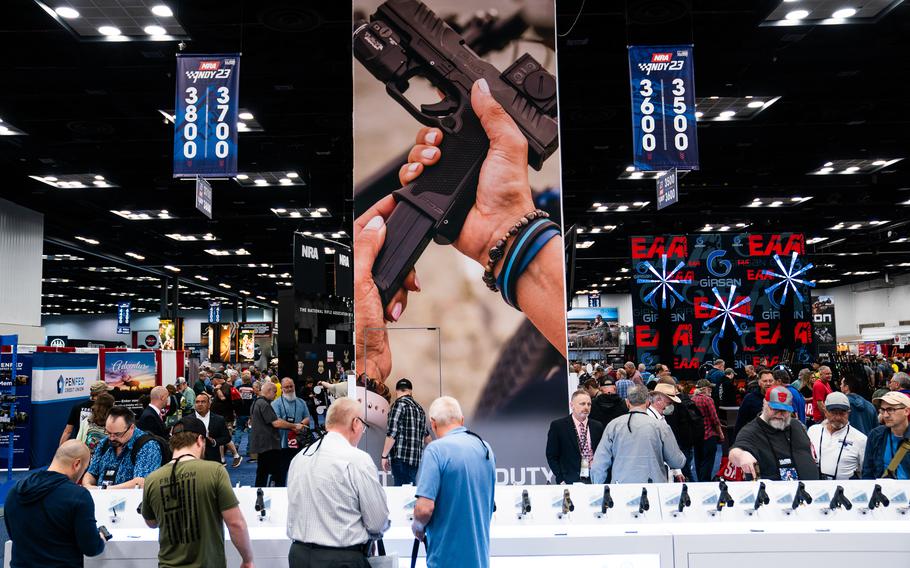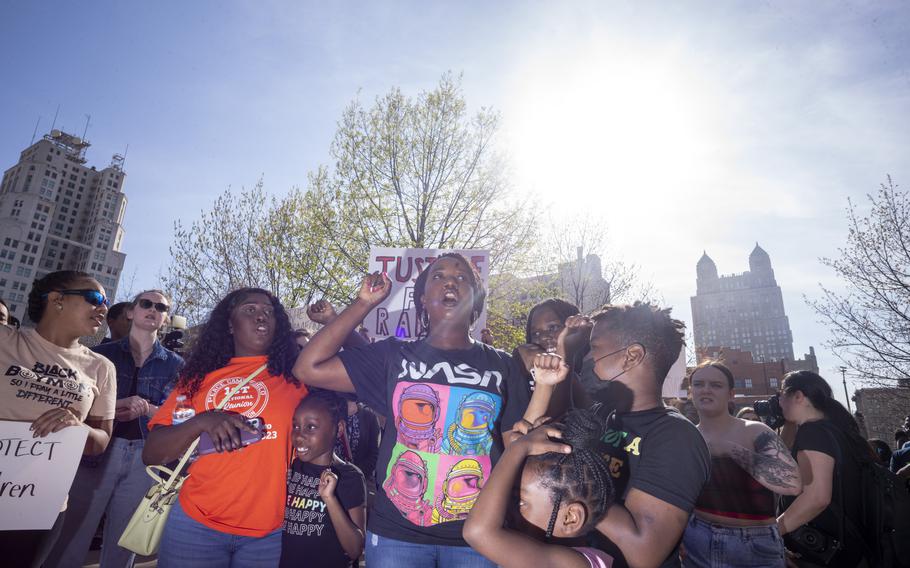U.S.
Why are Americans shooting strangers and neighbors? ‘It all goes back to fear’
The Washington Post April 30, 2023

Attendees look at guns during the National Rifle Association annual convention at the Indiana Convention Center in Indianapolis on April 14, 2023. (Demetrius Freeman/The Washington Post)
Steve Bridges had just parked his pickup truck at the Texas Boot Factory when he saw a man — white, maybe 55 or 60 — step out of the car beside him and slip a gun under his belt.
It was a Friday afternoon, three days after two cheerleaders opened the wrong car door in a supermarket parking lot nearby and were shot. Bridges, a 63-year-old contractor, had tried to picture how that could happen in Elgin, Tex., where eruptions of violence are rare.
“It all goes back to the fear,” he said. “Why are cheerleaders getting shot for opening the wrong door? Why is a grown man scared to go into a boot store without carrying his weapon? Why are these people so afraid?”
Across the country this month, at least four men have opened fire on someone who’d stumbled upon their space, resulting in one death, two injuries and a car pocked with bullet holes. The apparent acts of snap-aggression have reinvigorated the debate around the prevalence of “stand your ground” laws in the United States and a pressing question: Why are people so quick to pull the trigger on strangers?
Why did a 65-year-old man kill a 20-year-old woman who had accidentally pulled into his Upstate New York driveway? Why did an 84-year-old man fire two bullets into a 16-year boy who had mistakenly knocked on his Kansas City door? Why did a 43-year-old man in South Florida allegedly shoot at a 19-year-old Instacart delivery driver and his 18-year-old girlfriend who had arrived at the wrong address?
Experts blame a cocktail of factors: The easy availability of guns, misconceptions around stand-your-ground laws, the marketing of firearms for self-defense — and a growing sense among Americans, particularly Republicans, that safety in their backyard is deteriorating.
Since 2020, the share of Republicans who said that crime is rising in their community has jumped from 38% to 73%, according to the latest Gallup numbers from last fall. Among Democrats, that same concern climbed only 5 percentage points to 42%, marking the widest partisan perception gap since the polling firm first asked the question a half-century ago.
Reality is more complicated. A Washington Post crime analysis of 80 major police departments’ records found that reported violence across the country in 2022 was lower than the five-year average.
And over the longer term, the National Criminal Victimization Survey showed the number of people reporting sexual assault, robbery and other physical attacks is overall much lower now than in the 1990s and has not increased in recent years.
Homicides and thefts, however, rose during the pandemic according to Centers for Disease Control and Prevention data — though not to the levels of the 1990s.
A Post analysis, meanwhile, found that states with stand-your-ground laws had a 55% higher homicide-by-firearm rate in the past two years than the states that didn’t have these laws, which remove the duty to retreat from an attacker before responding with potentially deadly force.
The perception that life is getting more dangerous has spread on the right as GOP leaders and pundits repeatedly argued, without evidence, that immigrants and protesters are jeopardizing American peace. Conservative news channels have devoted more airtime to violence than their center- and left-leaning competitors: Over the past three years, for instance, Fox News anchors and guests spotlighted crime 79% more often than those on MSNBC and twice as much as voices on CNN, according to a Washington Post analysis 0f closed captioning provided by the GDELT AI Television Explorer and the Internet Archive.
Fear, paranoia and misunderstandings of the laws governing self-defense and use of force is a recipe for tragedy, said Geoffrey S. Corn, chair of criminal law at Texas Tech University Law School.
“We don’t demand any education for people who own firearms,” he said. “I was a soldier, and we couldn’t touch a live round without completing weeks of basic training.”
In Bastrop County, Bridges, the chair of the local Democratic Party, said the tension has been climbing for years.
Crime in the Central Texas county has ticked up in recent years, though less so than the national average. In 2021, according to the most recent data available, the small city of Elgin reported a total of 13 violent offenses, up from 10 in 2020.
Bridges kept his pistol at home and his door unlocked. Did crime seem worse to him? No.
Did it seem worse to the head of the local Republican Party?
“Crime has gotten worse,” said Curtis Courtney, a retired publisher. “It probably has. We have more illegals up here. We have a lot of people coming from Austin.”
Courtney, 70, didn’t know why that man had shot the cheerleaders. It was either a grave human error or a criminal act, or both, he figured, but it did not shake his belief that Americans should arm themselves wherever they saw fit.
“You have demonstrations in Portland and Chicago getting out of control,” he said.
Democrats who say crime isn’t getting worse, he said, “live on a river in Egypt. The de-Nile.”
That, he said, is why people carry a gun.
“We don’t have a problem,” he said. “The ones who try to bring it against us would have a problem.”

Organizers and community activists gather for a rally in honor of Ralph Yarl in Kansas City, Miss. (Doug Barrett/The Washington Post)
Andrew Lester, an 84-year-old White man, told officers he was “scared to death” earlier this month when he shot Ralph Yarl, a 16-year-old Black boy who had been looking for his siblings and knocked on his door in Kansas City.
“It’s the paranoia and fear,” said Lester’s 28-year-old grandson, Klint Ludwig. “It was the 24-hour news cycle — Fox News, OAN, all that stuff — pushing the civil division. Everybody is just so scared all the time.”
Over the years, he said, his grandfather had become hooked on those channels, echoing talking points that Ludwig, who describes himself as “left-leaning,” found disturbing. He recalled Lester describing migrant children detained at the border as a threat to national security.
“Minority groups get scapegoated,” Ludwig said. “The propaganda we see all day, every day was a detrimental force in his life.”
Lester’s neighborhood is full of houses with security systems, which isn’t unusual in Kansas City, said Jerry Nolte, 67, the presiding commissioner of Clay County, a Republican who’d recently door-knocked on the elderly man’s street.
The sheriff’s office reported that, according to the latest data, both violent and property offenses in the area actually dipped from 2017 to 2021. Nolte, a lifelong Kansas City resident, said he couldn’t tell if crime was up or down — only that people seemed more sensitive to it.
“Anybody who watches the news and sees nationwide the kind of crime stories reported are naturally going to be affected by that,” he said.
In rural Hebron, N.Y., where Kevin Monahan gunned down Kaylin Gillis earlier this month after she and her friends accidentally pulled into his driveway, residents of the dairy town had gathered in shock.
Monahan, a contractor, had kept to himself, said George Flint, 70, a Republican councilman. When Flint asked Monahan for a quote on a home renovation project years ago, the contractor seemed intelligent. A bit stiff. Nothing like a killer.
“I blame all this crap on TV,” Flint said. “The fact that you think you can chase somebody off your property like that in this day and age — when you don’t even know who they are — is absurd.”
Especially in Washington County, where, from 2019 to 2021, authorities reported just one homicide and four robberies.
“My client was involved in a series of tragic mistakes, made by more than one person, that resulted in the death of a young lady,” Monahan’s lawyer told reporters last week. “He feels terrible that a life was lost.”
He believed that he was defending himself, the lawyer added.
Jeremy B. Merrill and Andrew Ba Tran contributed to this report.